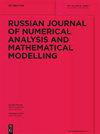各种物理鞍点问题的一般有限体积框架
IF 0.6
4区 数学
Q4 MATHEMATICS, APPLIED
Russian Journal of Numerical Analysis and Mathematical Modelling
Pub Date : 2021-12-01
DOI:10.1515/rnam-2021-0029
引用次数: 2
摘要
摘要本文研究了用于离散化和求解各种物理鞍点问题的一般有限体积框架。该框架应用Ostrogradsky-Gauss定理将偏微分方程的发散部分转化为表面积分,近似为界面上矢量通量的总和。利用谐波平均点的概念重构了界面矢量通量,即使在非均质各向异性介质中也能得到唯一的矢量通量。在矢量未知数处,考虑矩阵系数的特征值对矢量通量进行了修正,以解决双曲和鞍点问题,这些问题会引起非物理振荡和内支撑稳定性问题。我们将该框架应用于各种物理问题,即不可压缩弹性问题,不可压缩Navier-Stokes, Brinkman-Hazen-Dupuit-Darcy, Biot和Maxwell方程,并解释了应用中的几个细微差别。最后,我们在简单解析解上对框架进行了测试。本文章由计算机程序翻译,如有差异,请以英文原文为准。
General finite-volume framework for saddle-point problems of various physics
Abstract This article is dedicated to the general finite-volume framework used to discretize and solve saddle-point problems of various physics. The framework applies the Ostrogradsky–Gauss theorem to transform a divergent part of the partial differential equation into a surface integral, approximated by the summation of vector fluxes over interfaces. The interface vector fluxes are reconstructed using the harmonic averaging point concept resulting in the unique vector flux even in a heterogeneous anisotropic medium. The vector flux is modified with the consideration of eigenvalues in matrix coefficients at vector unknowns to address both the hyperbolic and saddle-point problems, causing nonphysical oscillations and an inf-sup stability issue. We apply the framework to several problems of various physics, namely incompressible elasticity problem, incompressible Navier–Stokes, Brinkman–Hazen–Dupuit–Darcy, Biot, and Maxwell equations and explain several nuances of the application. Finally, we test the framework on simple analytical solutions.
求助全文
通过发布文献求助,成功后即可免费获取论文全文。
去求助
来源期刊
CiteScore
1.40
自引率
16.70%
发文量
31
审稿时长
>12 weeks
期刊介绍:
The Russian Journal of Numerical Analysis and Mathematical Modelling, published bimonthly, provides English translations of selected new original Russian papers on the theoretical aspects of numerical analysis and the application of mathematical methods to simulation and modelling. The editorial board, consisting of the most prominent Russian scientists in numerical analysis and mathematical modelling, selects papers on the basis of their high scientific standard, innovative approach and topical interest.
Topics:
-numerical analysis-
numerical linear algebra-
finite element methods for PDEs-
iterative methods-
Monte-Carlo methods-
mathematical modelling and numerical simulation in geophysical hydrodynamics, immunology and medicine, fluid mechanics and electrodynamics, geosciences.

 求助内容:
求助内容: 应助结果提醒方式:
应助结果提醒方式:


